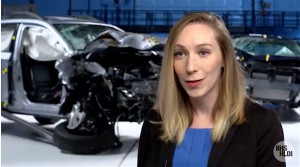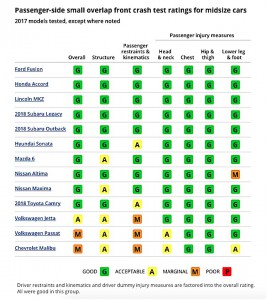
IIHS Senior Research Engineer Becky Mueller says the new passenger-side offset testing gives a clearer picture of how safe a car is.
The Insurance Institute for Highway Safety is implementing a new passenger-side offset impact test for 2017–18 models after discovering makers weren’t always providing the same level of protection to both front-seat passengers.
Individual models will now have to earn good or acceptable passenger-side ratings in order to qualify for IIHS’ Top Safety Pick + award.
Last year, the organization found inconsistencies in passenger-side small overlap test results on seven small SUVs from the 2014 through 2016 model years that had good ratings for driver-side protection.
The 2016 Hyundai Tucson offered equal protection for the driver and passenger in the front seat according to the testing, i.e. earning a “good” rating while the others scored poor or acceptable.
(Not buckling up in back? You’re putting everyone at risk. For the story, Click Here.)
With the new standard in place, IIHS reports that the first test group in the passenger-side small overlap front test program – midsize cars – did better overall than vehicles IIHS previously evaluated for research. Ten out of 13 midsize cars tested earn a good rating, while one is acceptable and two earn a marginal rating.
In contrast with a group of 2014–16 model small SUVs tested, none of the 2017–18 midsize cars had a poor or marginal structural rating. Instead, the biggest problem in the new group was inconsistent airbag protection in five cars, which could put passengers’ heads at risk, IIHS noted.
“The midsize cars we tested didn’t have any glaring structural deficiencies on the right side,” says IIHS Senior Research Engineer Becky Mueller. “Optimizing airbags and safety belts to provide better head protection for front-seat passengers appears to be the most urgent task now.”
(Click Here to see why the federal government was sued over seat belt warnings.)
Automakers have made important changes to vehicle structures and restraints to earn good ratings in the driver-side small overlap front test.
IIHS engineers initially focused on driver-side protection because every vehicle on the road has a driver, but not every vehicle has a passenger. It also was clear that what works for small overlap protection on the left side might not work on the right, since vehicles are to a certain extent asymmetrical.
Once manufacturers solved the small overlap problem on the driver side, the Institute wanted to see them use that know-how on the passenger side as well. Among the midsize cars, all of which have good driver-side ratings, the Subaru Outback and Legacy were two of the top performers in the new test.
(To see more about how driver assistance tech is saving lives, Click Here.)
The Subaru Forester, Chevrolet Malibu and the Volkswagen Passat earn a marginal passenger-side rating. In both cars, the passenger dummy’s head slid off the front airbag and contacted the dashboard. Measures taken from the dummy showed head injuries would be possible in a real-world crash of the same severity.
